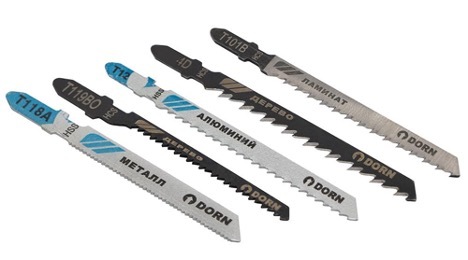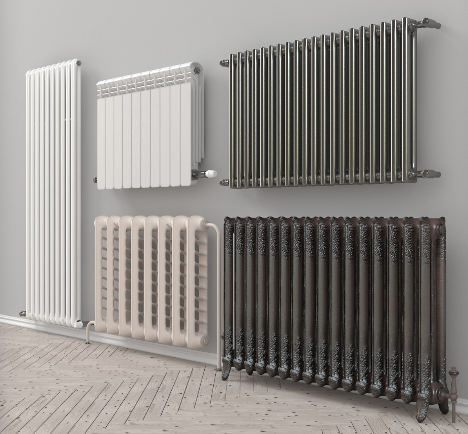Today, dozens of different types of canvases are produced. They can be used to treat any surface. The article describes jigsaw files, presents their types and features, as well as the main selection criteria for different cases.
The content of the article
- How files are marked
-
Types of files
- To size
- Edge shape
-
Material classification
- For wood
- For metal
- For polymer metal
- For special tasks
How files are marked
Each canvas has its own designation. A unified system has not been developed, but in practice, marking of jigsaw files with decoding from Bosch is most often used. According to this system, a combination of letters and numeric characters is indicated on the tail.
The first letter can be either U or T for the corresponding shank type. After the letter comes a number that shows the length of the file (indicated in millimeters):
- 1 denote short, reach a maximum of 75;
- 2 denote standard, minimum 75 mm, maximum 90;
- 3 mark extended, minimum 90 mm, maximum 150;
- 4 are long, they start at 150.
After the digital sequence, there are again letters that indicate the size of the teeth:
- A - small;
- B - medium sizes, for example, for wooden surfaces;
- C, D - large sizes, for a rough cut.
There is also the last letter for which you can get additional information:
- F - from an alloy based on 2 metals, a high degree of strength;
- O - with a small width, used for figured sawing;
- P - dense blades, these types of jigsaw files allow you to work exactly perpendicular;
- R - blade equipped with a reverse tooth;
- X - teeth of different sizes, can be used to work with a variety of surfaces.

There is also such a marking of saw blades for an electric jigsaw, associated with the color that the shank has:
- gray - used only for wood blanks;
- blue - for metal;
- white - can be used for both;
- red - only for plastic parts;
- black - for other materials.
There may be specific designations that mark the composition of the metal of the web:
- CV - steel, which includes the metals vanadium and chromium;
- HCS - with a high concentration of carbon;
- HSS - files that can be used for metal;
- HM - in this case, the main one is the combination of tungsten with carbon, such cuts are used for dense materials, such as ceramics.
On the one hand, according to the sequence of letters and numbers, you can figure out how to choose a file for a jigsaw. But there are other equally important indicators that are also worth considering.
Types of files
The canvas is divided according to dimensions, according to the shape of the edge, the type of surface with which they work. The main parameters are discussed below.
To size
There are 3 sizes, and each of them must be considered when choosing a file. Along the length, there is a marking for jigsaw files, described above. In general, this parameter can range from a minimum of 40 to a maximum of 250 (indicated in millimeters). Moreover, the higher the indicator, the thicker the workpiece can be. The depth largely depends on the jigsaw itself, its power.
Width - it is selected depending on the purpose. If you need to cut a straight shape, wide files are best suited. And if curly - a canvas that does not have a wide back is suitable.
Edge shape
If we talk about what kind of jigsaw files are, it is worth mentioning the geometry. All elements are separated from each other in different ways. And the greater the degree of dilution, the greater the cut line, so it will be easier and faster to work.
This is one of the main ways to choose a jigsaw file. There is a wiring parameter, according to this criterion, 2 groups are distinguished:
- Milling.
- Grinding.

Milling machines can have classic and wavy wiring. In the first case, the teeth are alternately bent in different directions. Wavy equipment consists of teeth that have different deviations. As a result, the edge takes the form of a wave.
Grinding types of jigsaw files can also be classic (by wiring). Their teeth are bred at the same interval. Therefore, the cuts are of sufficient quality, and besides, they can be done at high speed. Can be used for plywood and other wooden blanks.
There are also varieties that have a conical type of grinding. They can be used for metal, wooden blanks, as well as for plastic products. The teeth are organized into groups with the same amount of deflection.
Material classification
It is also recommended to study the following question: what are the files for a jigsaw according to the criterion of material composition. Often the tool is used for woodworking, but there are other types of blanks.
For wood
In most cases, the device works with wooden surfaces. The marking of saw blades for electric jigsaw is described in the table or list, as presented above. There are different types of cuts, for example, fast. Canvases with the following numbers are suitable for him:
- length not less than 60 mm;
- teeth of large dimensions, the parameter is within 6 mm;
- large divorce, reaches 1 mm.

A clean cut allows you to work with a parquet board, furniture boards. They have teeth within 3 mm. And the divorce is small.
To make a figured cut, tools are used that allow you to easily pass round sections. They have the following options:
- width within 4 mm;
- small teeth up to 2 mm;
- the length is also small - within 40 mm;
- noticeable bevel on the back.
For metal
The marking of the jigsaw blades that work on a metal surface is blue. In this case, the files have several features:
- made of high strength steel;
- the teeth are small, within 1 mm;
- breeding wavy type.
If the tool is often used to work with metal, you should purchase different files - for aluminum blanks, steel and non-ferrous metal.
For polymer metal
To cut a pipe and other PVC products, use a file with large teeth. They are suitable for both metals and wood. If the blade has small teeth, they can also be used for similar tasks. But then you need to work at low speeds.
For special tasks
It is useful to understand how to choose a file for a jigsaw for wood, as well as for parts of a different composition. Sometimes you have to choose canvases for working with ceramics or glass. They should consist of a material that gives special strength - it can be sputtering of tungsten with carbon or diamond.
Thus, the choice of a jigsaw file is made based on different parameters. It is best to choose a set of canvases for different purposes. Then it will be possible to effectively use cuts for almost all cases.


